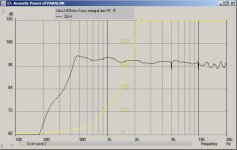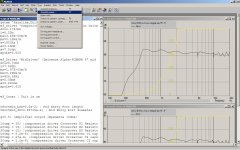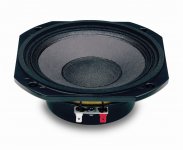so I had it backwards, the HornResp output is fine so long as I'm modeling a CD horn. I just can't get as detailed in HR.
I see the Paraline in your script. S2- S4 expand slowly. That must be it. S4-S5 looks like a conventional conical segment. You appear to be doing the mount the mid over the CD trick with all those ducts from the mids front chamber down into the WG at the tap point. Now we know why you wanted such a small CD...
Sharp man! That is exactly how the mid is being mounted. This allows the use of a single large mid with multiple small ports. This keeps the ports small so they don't interfere with the compression driver's response, and also keep the port velocity low too. With 100W input the port velocity is still below 17 m/s.
This was a continuation of ideas from the Paraline patent and seeing the video of the new Danley Paraline BLH. I circled back around to the paraline because I've gone around and around with the conventional Synergy with very limited success. The construction of a paraline based Synergy will be less complicated. I already have several sheets of 3/16" machinable nylon for the paraline construction. I hope this will be it.
JLH,
Thanks for the Synergy Akabak script. I just ran it and that is some crazy efficiency you have going on there in the high frequencies. With 2.83v input at 1m the highs are hitting 120dB! Is that correct? The CD will have to be padded down to match the 105dB output from the mids. How were you going to handle the bass below 400Hz - external woofer or in-horn?
Thanks,
X
Thanks for the Synergy Akabak script. I just ran it and that is some crazy efficiency you have going on there in the high frequencies. With 2.83v input at 1m the highs are hitting 120dB! Is that correct? The CD will have to be padded down to match the 105dB output from the mids. How were you going to handle the bass below 400Hz - external woofer or in-horn?
Thanks,
X
Attachments
Sharp man! That is exactly how the mid is being mounted. This allows the use of a single large mid with multiple small ports. This keeps the ports small so they don't interfere with the compression driver's response, and also keep the port velocity low too. With 100W input the port velocity is still below 17 m/s.
This was a continuation of ideas from the Paraline patent and seeing the video of the new Danley Paraline BLH. I circled back around to the paraline because I've gone around and around with the conventional Synergy with very limited success. The construction of a paraline based Synergy will be less complicated. I already have several sheets of 3/16" machinable nylon for the paraline construction. I hope this will be it.
That sounds like a really good plan! The only negative I've heard is that the paraline doesn't have a smooth/flat frequency response - Nate Hansen's posts in square pegs thread. That should yield to equalization...
Good luck with it!
JLH,
The CD will have to be padded down to match the 105dB output from the mids.
I thought the mids would 'fill in' the missing output around 1khz
JLH,
Thanks for the Synergy Akabak script. I just ran it and that is some crazy efficiency you have going on there in the high frequencies. With 2.83v input at 1m the highs are hitting 120dB! Is that correct? The CD will have to be padded down to match the 105dB output from the mids. How were you going to handle the bass below 400Hz - external woofer or in-horn?
Thanks,
X
Don't look at the acoustic pressure, look at the acoustic power. This will end up being a 3-way to fill in below 450Hz. I'm shooting for a low end around 100Hz.
That sounds like a really good plan! The only negative I've heard is that the paraline doesn't have a smooth/flat frequency response - Nate Hansen's posts in square pegs thread. That should yield to equalization...
Good luck with it!
I believe I've found some of the reasons for the high frequency issues. This next build will confirm if my ideas are correct. I hope so.
I thought the mids would 'fill in' the missing output around 1khz
The simulation in question was ran as acoustic pressure instead of acoustic power in Akabak. If the simulation is ran as acoustic power it is beautiful. Probably some of my better work.
Jlh,
Ok I will give the acoustic power a try. I noticed you have quite an extensive crossover network going on - in your experience does AkAbak do a pretty good job of predicting the performance including how to set up the crossover? That is, do you still need to build first, then do measurments to refine the XO values, or it comes pretty close from the simulation?
Ok I will give the acoustic power a try. I noticed you have quite an extensive crossover network going on - in your experience does AkAbak do a pretty good job of predicting the performance including how to set up the crossover? That is, do you still need to build first, then do measurments to refine the XO values, or it comes pretty close from the simulation?
Last edited:
The only negative I've heard is that the paraline doesn't have a smooth/flat frequency response - Nate Hansen's posts in square pegs thread. That should yield to equalization...
The rough freq response of my Paralines is due more to my construction I think than the design itself. My Paralines aren't quite symmetrical, and the mid ports aren't quite either. Couple that to horns made from hardened cardboard and you have a recipe for raggedness
I believe I've found some of the reasons for the high frequency issues. This next build will confirm if my ideas are correct. I hope so.
Care to share or do you want to experiment first?
Jlh,
Ok I will give the acoustic power a try. I noticed you have quite an extensive crossover network going on - in your experience does AkAbak do a pretty good job of predicting the performance including how to set up the crossover? That is, do you still need to build first, then do measurments to refine the XO values, or it comes pretty close from the simulation?
If your model is very close to what you build, then the crossover only requires tweaking. For this reason I normally buy the coils about two standard values higher and measure the results. I then unwind the coils as needed to fine tune the crossover. I always have plenty of caps on hands.
Care to share or do you want to experiment first?
I want to experiment first. I don't want to get everyone excited then it fall through. I've hit so many dead ends with this stuff its not funny.
Ok, here is a stupid question - how do you get Akabak to calculate the acoustic power? There is a power spectrum dialog but it says missing input when I select it...
Click Sum from the menu bar at the top and select acoustic power. It should be the second selection under the Sum menu. With the scritp I posted, it should look like the attached graph.
Attachments
If anyone is wondering about the spikes at 5KHz and 10KHz they directly correspond to the 3.5cm distance from the mid's cone to the mounting surface. This suggests I might want to add some poly batting around the port holes to stop this reflection. In addition, since Akabak is showing these spikes but nothing relating to the mid ports I'm confident the ports will be acoustically invisible to the compression driver as I predicted.
Here, like this
Ok, that works - thanks. Your Synergy design is very nice - flat in acoustic power. Now this begs the question: should we be designing for flat response in SPL (pressure level) or Power? I have been going the former route - and that appears to be how measurements are presented. Is the power what the ear hears for an even response across the frequency range? This is where room EQ comes in?
Ok, that works - thanks. Your Synergy design is very nice - flat in acoustic power. Now this begs the question: should we be designing for flat response in SPL (pressure level) or Power? I have been going the former route - and that appears to be how measurements are presented. Is the power what the ear hears for an even response across the frequency range? This is where room EQ comes in?
This still has me confused. Recall (per hornresp help) that "the constant directivity SPL response is also the acoustical power response" and vice versa. I think that means in this context that to the extent that the acoustic power is contained within and evenly distributed within the "cone" defined by the horn walls, the two are the same. If you've got flat power, you must also have flat pressure.
re' the many small mid holes vs 4 large ones
That could be a compelling advantage. Getting the holes right seems to be one of the biggest challenges to doing a Synergy. In your case, the holes don't have corners to hide in but they are acoustically small. I guess that is what makes this "interesting"
That could be a compelling advantage. Getting the holes right seems to be one of the biggest challenges to doing a Synergy. In your case, the holes don't have corners to hide in but they are acoustically small. I guess that is what makes this "interesting"
- Home
- Loudspeakers
- Multi-Way
- Suitable midrange cone, for bandpass mid in Unity horn.



